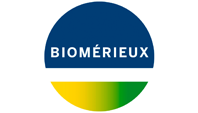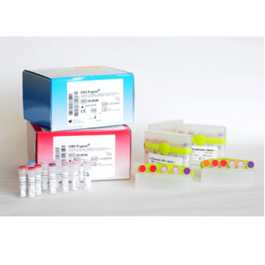Enterovirus R-GENE®
A real-time PCR kit for the accurate detection of enterovirus RNA
- Ready-to-use kit that includes internal, positive and negative controls
- CE-IVD on all major extraction platforms & real-time PCR systems and on different samples types
Ajouter à ma sélection
Avez-vous besoin de plus d'informations?
Enterovirus R-GENE® advantages
Enteroviruses are common human viruses associated with diverse clinical syndromes ranging from minor febrile illness to rare but severe and potentially fatal conditions (e.g., aseptic meningitis, paralysis, myocarditis, and neonatal enteroviral sepsis). Numerous enterovirus serotypes have been identified with different temporal patterns of circulation; typically they are associated with different clinical manifestations. Changes in circulating serotypes can result in large-scale outbreaks, as people will not have built up immunities. Optimized detection of enterovirus infection is critical to ensure the best patient management, especially for the diagnosis of neuro-meningitis infections on CSF samples. Enterovirus R-GENE® is an ideal solution.
- Sensitive and reproducible
- Reliable measurement of enterovirus infection
- All controls included
- Standardized
- Uniform processing with other viruses using HSV1 HSV2 VZV R-GENE® and Parechovirus R-GENE® assays.
- Harmonized test profiles for multiple assays in one run
- Flexible
- Validated for use on CSF and other samples types
- Qualified for use with manual or automated sample preparation such as EMAG® and NUCLISENS® easyMAG® assay setup techniques such as ESTREAM® liquid handling system
- Qualified with the major real-time PCR platforms
One kit for everything you need
The Enterovirus R-GENE® kit is a ready-to-use molecular detection kit. It measures the presence of enterovirus using real-time PCR after viral RNA extraction. This 5’ nuclease-based real-time PCR assay amplifies a specific region of Enterovirus genome.
- An Internal Control (IC1) checks the extraction process, including lysis, and the presence of amplification inhibitors in the sample
- Positive and Negative controls
- Includes all necessary reagents optimized to detect enteroviruses for in vitro diagnostic use
Simple procedure
Using the Enterovirus R-GENE® kit is easy. Just add the extracted RNA sample to the ready-to-use PCR master mix and start the reaction on the appropriate Real-Time PCR thermocycler, following optimized cycling program described in the “Instructions For Use”.
BIOMERIEUX, the blue logo, ARGENE®, R-GENE®, EMAG® or NUCLISENS® easyMAG® are used, pending and/or registered trademarks belonging to bioMérieux, or one of its subsidiaries, or one of its companies. Any other name or trademark is the property of its respective owner.
| Enterovirus R-GENE® (69-005B) | |
|---|---|
| Principle of the test | Genomic detection of Enteroviruses |
| Ordering information | Reference 69-005B: Enterovirus R-GENE® |
| Technology | Real-Time PCR / 5‘ nuclease Taqman technology |
| Gene target | 5’ non coding region |
| Serotypes detected | Enterovirus A: Coxsackievirus A4, A6 to A8, A10, A14, A16, A16V Enterovirus 71,76 Enterovirus B: Coxsackievirus A9, B1 to B6, Echovirus 1 to 7, 9, 11 to 21, 24 to 27, 29 to 33, Enterovirus 69, 74,75, 77, 78, 93 Enterovirus C: Coxsackievirus A11, A13, A17, A20, A21, A24, A24V Poliovirus 1,2,3 Enterovirus D: Enterovirus 68, 70,94 |
| Specimen* | CSF, Stool, Respiratory specimen, cell culture |
| Controls included | Extraction + Inhibition control, positive, negative control |
| Results within | 2 hours (extraction step not included) |
| Reporting unit | Qualitative test |
| Number of tests | 90 tests |
| Storage conditions | -15°C/-31°C |
| Validated Extraction platform* | EMAG® NUCLISENS® easyMAG® |
| Validated Amplification platform* | ABI7500 Fast, ABI 7500 Fast Dx LightCycler 480 System II Rotor-Gene Q CFX96 |
| Status | For in vitro diagnostic use, CE marking in Europe - Please enquire |
* please enquire
Fast facts on Enteroviruses
What are Enteroviruses?
Members of the Picornaviridae family, enteroviruses are single-strand RNA viruses, split into 4 species (Enterovirus A, B, C and D). More than 100 serotypes have been described, of which 68 are currently recognized in the 2005 international classification (8th report of the International Committee on the Taxonomy of Viruses. 2005). In temperate climates, enterovirus infections mostly occur seasonally (May to October) and are particularly common infections in children and adolescents. Enteroviruses are the leading cause of meningitis and are also associated with cardiac, respiratory, cutaneous mucosa or neonatal pathologies.
Who is most at risk?
Anyone can become infected and ill with these viruses. However, infants, children and adolescents are more prone to become ill than are adults. Adults are more likely to be immune to specific enteroviruses.
What are the benefits of Enteroviruses molecular testing?
The standard method for the diagnosis of enteroviruses is isolation by cell culture followed, if necessary, by a sero-neutralisation typing. However, this traditional method sometimes lacks sensitivity for certain serotypes (Coxsackievirus A and enterovirus 68 to 71). Currently, the method of choice for the diagnosis of these neuro-meningitis infections is the molecular diagnosis on CSF samples. Much faster than conventional PCR methods, Real Time PCR enables a rapid and sensitive identification of all the serotypes, allowing clinicians to discontinue unnecessary treatment and useless clinical examinations.
Enterovirus R-gene®: PUBLICATIONS



